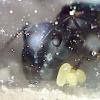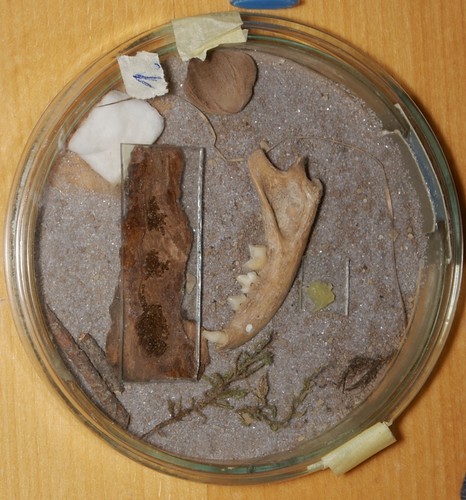Glad to hear that they are making a comeback so quickly.
- Formiculture.com
- Forums
- Gallery
- Members
- Member Map
- Chat

Glad to hear that they are making a comeback so quickly.
"Always do right. This will gratify some people, and astound the rest." -- Samuel Clemens
April 1, 2015
They are doing well although THA growth chamber they are in is currently overcrowded. They have a formicarium coming but in 2 or 3 weeks from now.
I am currently giving them food via a connection port. I cannot open it because they have a tendency to climb walls and spread out. This is a behavior that's opposite of Formica subsericea which simply refuse to climb walls.
I see a fair amount of eggs now.
April 9, 2015
So... finally the big move.
It was a long excruciating labor to move them one by one.
After moving ants, I moved brood. What I do is place brood on small dishes and simply place them in the outworld and ants will pick them up eventually.
For now, most ants are under shade, but they will eventually move into the nest because there is high level of moisture down there. It's important that I do not give them a water source in outworld until they move into the nest.
Edited by dean_k, April 9 2015 - 4:29 PM.
April 12, 2015
They've settled down above where water tower is in their new formicarium. It took them a day and half but they got there which was expected.
However, they have yet to explore the outworld since settling down. I see few (1 ~ 3) workers exploring the nest itself but none has gone above. I am not concerned at the moment despite of their passive behavior because there are very few larvae at the moment. They may be feeling that they don't need protein right now. A lot of pupae and I see there are more eggs.
You can see all three queens from the video but the queens aren't very distinguishable.
April 16, 2015.
I am troubled. While they've laid a bunch of eggs, they are not exploring at all. Since my last update (Apr, 12), I've yet to see them exploring the outworld.
The mealworm piece you see in the video is something I dropped by opening the side glass.
I may need to move them back to a smaller, simpler, formicarium.
If they don't start foraging in another week, I would remove the side piece and remove them from the tunnels.
I would then plug the entrance to the tunnels with cotton and put a test tube in the outworld. Let them live in the test tube until there are literally too many ants to fit inside the test tube. This species seems to do pretty good in test tubes.
I find smaller colonies of Myrmica don't forage very far away. An issue I had with my very first colony, they never made it down all 6" of tubing to the outworld. At least until the worker count pushed 80+ workers.
Or if you don't want test tubes, anything that provides shelter and humidity would work. If I thought their old nest would fit in the outworld I would suggest that.
Or you could do something like this while you wait for the colony to grow. A piece of wood with some glass on top. It would allow you to use the outworld, and let them get used to it.

"Always do right. This will gratify some people, and astound the rest." -- Samuel Clemens
The thing is the other Myrmica colony (the one with 2 queens), the first one I've gotten from you forage fine from a very similar setup.
I am not sure then.
I have noticed that every colony, even if they are the same species, often behave differently.
Perhaps the die off claimed the older workers who were used to foraging, and the ones left still haven't adapted to their new roles.
Maybe when this wave of pupae ecloses it will prompt the workers to go further.
"Always do right. This will gratify some people, and astound the rest." -- Samuel Clemens
Cool colony, looks to maybe be the same species as me! I hope they bounce back nicely for you!
I am not sure then.
I have noticed that every colony, even if they are the same species, often behave differently.
Perhaps the die off claimed the older workers who were used to foraging, and the ones left still haven't adapted to their new roles.
Maybe when this wave of pupae ecloses it will prompt the workers to go further.
True, every colony is different. And I do feel the mass die-off may have something to do with their odd behaviors which is why I am thinking that a simpler setup is needed like the containers I am using for Lasius and Formica colonies.
April 20, 2015
Well, duh, last night I finally found out why they weren't foraging.
They were ... slipping.
Yes, they couldn't get out. Apparently, the smooth part of nest entrance was too much of slope for them to climb. My solution was simple. Just insert a piece of tube for more traction.
And... what do you know. They are foraging and drinking.
Great that you figured it out!
Myrmica aren't the best climbers out there. I have tied sand paper to a pipe cleaner and pulled it though my tubing to create lots of little scratches for them several times before.
"Always do right. This will gratify some people, and astound the rest." -- Samuel Clemens
Those queens have huge gasters! Can't wait for them to start pumping out eggs.
April 22, 2015
The colony is doing okay. The queens laid a lot of eggs since their forced relocation. They are yet to turn into larvae yet.
I know they are finally drinking sugar water but I haven't seen them wanting protein as they ignored few pieces of mealworms so far. But there are very little larvae at the moment and there are plenty of eggs. I don't think they want much protein intake yet.
Meanwhile, one of pupae, especially the one in middle with its head facing the camera, looks unusually large. I highly doubt it is an alate however.
Interesting. I wouldn't be surprised if you ended up with an alate queen from that pupa. It's actually not that unusual for Myrmica colonies to produce alates this early.
That head size is of a queen's, not to mention the bigger thorax I can barely see. Since Myrmica has no majors, it is a possibility that it is indeed an alate. The colony is certainly old enough according to Crystal.
There is also an interesting larva on 1:29 by top right of the big pupa. I suggest viewing the video on Youtube and view it in theater mode where you can see it more clearly.
Edited by dean_k, April 21 2015 - 9:05 PM.
That larvae on top is closer to pupae than larvae. They slowly change like that and we often miss it.
It would not surprise me if that was an alate. That colony had alates once before - I think it was 4 queens? But no males, none of my smaller colonies had males yet.
Bit early for the spring flights,they are about 2 months or so ahead of the wild ones. But otherwise, they are pretty much on schedule. ![]()
"Always do right. This will gratify some people, and astound the rest." -- Samuel Clemens
That larvae on top is closer to pupae than larvae. They slowly change like that and we often miss it.
It would not surprise me if that was an alate. That colony had alates once before - I think it was 4 queens? But no males, none of my smaller colonies had males yet.
Bit early for the spring flights,they are about 2 months or so ahead of the wild ones. But otherwise, they are pretty much on schedule.
Have you ever tried introducing foreign males to the alate queens that your colonies produce? Myrmica spp. do often mate on the ground and occasionally within the nest.
Edited by Myrmicinae, April 22 2015 - 8:13 AM.
I have never found an alate male outside of their colony. And I never had queens when I found males in wild nests.
Only once did I have males in my colony. It was my first colony (wild-caught) and I will admit that I was still learning and experimenting - and I knew it. I didn't even attempt to find a queen alate in a wild nest and introduce them. I was just starting to play around with various nest materials and setups, and I was much more focused on that. I didn't see any point in trying to breed a species that is so common around here - and I read many threads that said it was nearly impossible.
The males were only tolerated for so long and then carried out of the nest.
Here is my old journal - http://antfarm.yuku....al#.Ug1U4G1DUTY
They were a great beginner colony who helped me with the many experiments that eventually led to my tutorial on how to build a grout nest (I did not document most of my experiments back then as most failed miserably). I do kind of miss them, despite the fact that I am not overly fond of the appearance of ants with 2 notes. All Myrmica I have ever kept have a certain character that I have not seen in any other species.
I sold them to an eager hobbyist since I had Formica, Camponotus and many other queens/colonies that I liked the looks of better. But looking back, I do wish that I had kept this colony. They were my first colony and helped me through my first steps.
"Always do right. This will gratify some people, and astound the rest." -- Samuel Clemens
April 29, 2015
I cannot say the colony is doing well because I see a fair amount of dead workers as seen in last part of the video (After 3:15). But they aren't doing bad, either. There are signs of revival in healthy amount of eggs. Regardless, I believe this species do not take relocation well, so I won't be relocating them anymore.
And the big pupae I mentioned in the last update turned out to be just a slightly bigger worker.
Furthermore, the tube wasn't the perfect solution for slipping, so I added a flexible pipe cleaner to make them even easier to climb out of the nest. As a result, there are a lot more ants in outworld. They like to farm sugary liquid sources, only going back to feed others.
I also had to add a second liquid feeder because the first one was overcrowded.
Edited by dean_k, April 29 2015 - 2:29 PM.
0 members, 1 guests, 0 anonymous users